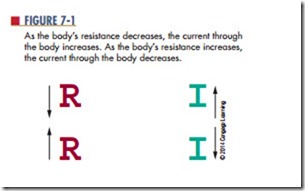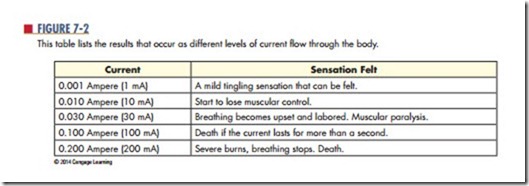Dangers of electricity
Nothing you learn in this book is more important than learning to work safely with electricity. Work smart and safe when dealing with electricity. You can help protect yourself and everyone around you from painful or even lethal shock. You can also help prevent fires.
During the winter months, the skin dries out, of- fering some insulation. When the skin becomes wet through water or sweat, the body resistance drops. The low resistance allows more current to pass through the body, resulting in impairment.
Chapter 11 discusses the flow of current that is measured in amperes. It is the flow of current through the body that causes pain and even death from electrical shock. Voltage is the pressure behind electrical current, but the current flow is more important than voltage when discussing electrical shock. Figure 7-1 shows that the body resistance is the inverse of cur- rent through the body. As body resistance decreases, the current through the body increases. When the body resistance increases, the current flow decreases through the body.
Electrical shock occurs when an electric current flows through the body when a complete circuit exists.
Different levels of current produce different results, as shown in Figure 7-2.
One technique to reduce current flow is to increase body resistance. Body resistance is high when the skin moisture content is low, and the skin has no cuts or abrasions at the point of electrical contact. In these situations, very little current flows, with a mild shock resulting.
If the situation were reversed, with high skin moisture content lowering the body resistance, a large cur- rent would flow. If the current flows through the chest region, the heart could go into ventricular fibrillation, resulting in rapid and irregular muscle contractions and leading to cardiac arrest and respiratory failure.
Factors that influence the effects of electrical shock are listed here:
● Intensity of the current
● Frequency of the current
● Current path through the body
● Length of time current passes through the body Remember, it is the amount of current flow through the body, not the amount of voltage contacted, which
determines the severity of a shock. The larger the cur- rent flow through the body, the greater the effect of the shock.
When dealing with someone who has experienced severe electrical shock, do not become part of the problem. First, send for help; then remove the source of power. Do not attempt to touch or pull the victim away without removing the power source, or you will also get yourself shocked.
If the power source cannot be secured, use a nonconducting material to remove the victim from the circuit. Once the victim is free, check for signs of breathing and pulse. If trained, begin cardiopulmonary resuscitation (cPr) if necessary. CPR is an emergency procedure performed by trained personnel to manually pump blood to the brain until further action can be taken by a qualified medically trained team to restore blood circulation and breathing for a person in cardiac arrest and respiratory failure.

